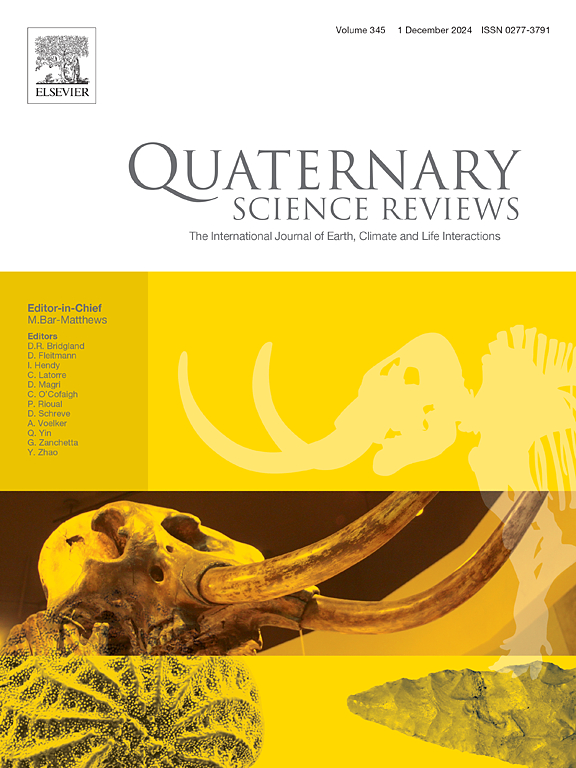Explosive volcanic history of Snæfellsjökull, West Iceland: Geochemistry, chronology and tephra distribution
IF 3.2
1区 地球科学
Q1 GEOGRAPHY, PHYSICAL
引用次数: 0
Abstract
Tephrochronology is firmly rooted in our knowledge of volcanic history. Iceland's Holocene explosive volcanic history is predominantly derived from investigations of soil sections and written archives, following the Norse Settlement c. 877 CE. Unsurprisingly, historically active volcanic provinces are most often the target of these tephrochronological investigations (e.g., Hekla, Katla, Bárðarbunga-Veiðivötn and Grímsvötn). Despite the risk of large explosive eruptions, some volcanic provinces – like Snæfellsjökull have received less attention. While no historical eruptions have been described from the glaciated central volcano, mapping from the late 1960s and early 1980s suggests there have been at least three explosive eruptions (producing silicic tephra) during the Holocene: Sn-1 (∼1.8 ka BP), Sn-2 (∼4.4 ka BP) and Sn-3 (∼8–10 ka BP). The presence of at least two of these tephra layers in European stratigraphic records has been suggested. Furthermore, other (cryptotephra) horizons in Europe exhibit similar geochemical properties to the Snæfellsjökull province, albeit different age estimates than Sn-1, -2, or -3. The tephrochronological potential of Snæfellsjökull tephra is limited by our lack of fundamental knowledge on the volcanic history and the potential range in tephra geochemistry from this stratovolcano. As a step towards addressing this knowledge gap, we present a well-dated record of tephra stratigraphy from lake Laugarvatn, near Snæfellsjökull. Furthermore, we review all Snæfellsjökull-like tephra deposits to improve understanding of Snæfellsjökull's post-glacial explosive volcanic activity affecting both regional and distal environments.
冰岛西部Snæfellsjökull火山爆发史:地球化学、年代学和火山分布
火山年代学牢牢扎根于我们对火山历史的了解之中。冰岛的全新世爆发火山历史主要来自于对土壤剖面的调查和书面档案,在公元877年挪威人定居之后。不出所料,历史上活跃的火山省通常是这些火山年代学研究的目标(例如,Hekla, Katla, Bárðarbunga-Veiðivötn和Grímsvötn)。尽管存在大规模爆发的风险,一些火山省份——比如Snæfellsjökull——受到的关注较少。虽然没有从冰川中心火山的历史喷发描述,从1960年代末和1980年代初的测绘表明,在全新世期间至少有三次爆炸性喷发(产生硅质火山):Sn-1 (~ 1.8 ka BP), Sn-2 (~ 4.4 ka BP)和Sn-3 (~ 8-10 ka BP)。在欧洲的地层记录中,至少存在两个这样的温弗拉层。此外,欧洲的其他(隐隐层)层也表现出与Snæfellsjökull省相似的地球化学性质,尽管年龄估计与Sn-1、-2或-3不同。由于缺乏对该层状火山的火山历史和层状火山地球化学潜力范围的基本认识,限制了Snæfellsjökull层状火山的层状火山年代学潜力。作为解决这一知识差距的一步,我们提出了来自Snæfellsjökull附近的Laugarvatn湖的一个年代久远的tephra地层记录。此外,我们回顾了所有Snæfellsjökull-like tephra矿床,以提高对Snæfellsjökull冰川后爆发火山活动影响区域和远端环境的理解。
本文章由计算机程序翻译,如有差异,请以英文原文为准。
求助全文
约1分钟内获得全文
求助全文
来源期刊

Quaternary Science Reviews
地学-地球科学综合
CiteScore
7.50
自引率
15.00%
发文量
388
审稿时长
3 months
期刊介绍:
Quaternary Science Reviews caters for all aspects of Quaternary science, and includes, for example, geology, geomorphology, geography, archaeology, soil science, palaeobotany, palaeontology, palaeoclimatology and the full range of applicable dating methods. The dividing line between what constitutes the review paper and one which contains new original data is not easy to establish, so QSR also publishes papers with new data especially if these perform a review function. All the Quaternary sciences are changing rapidly and subject to re-evaluation as the pace of discovery quickens; thus the diverse but comprehensive role of Quaternary Science Reviews keeps readers abreast of the wider issues relating to new developments in the field.
 求助内容:
求助内容: 应助结果提醒方式:
应助结果提醒方式:


